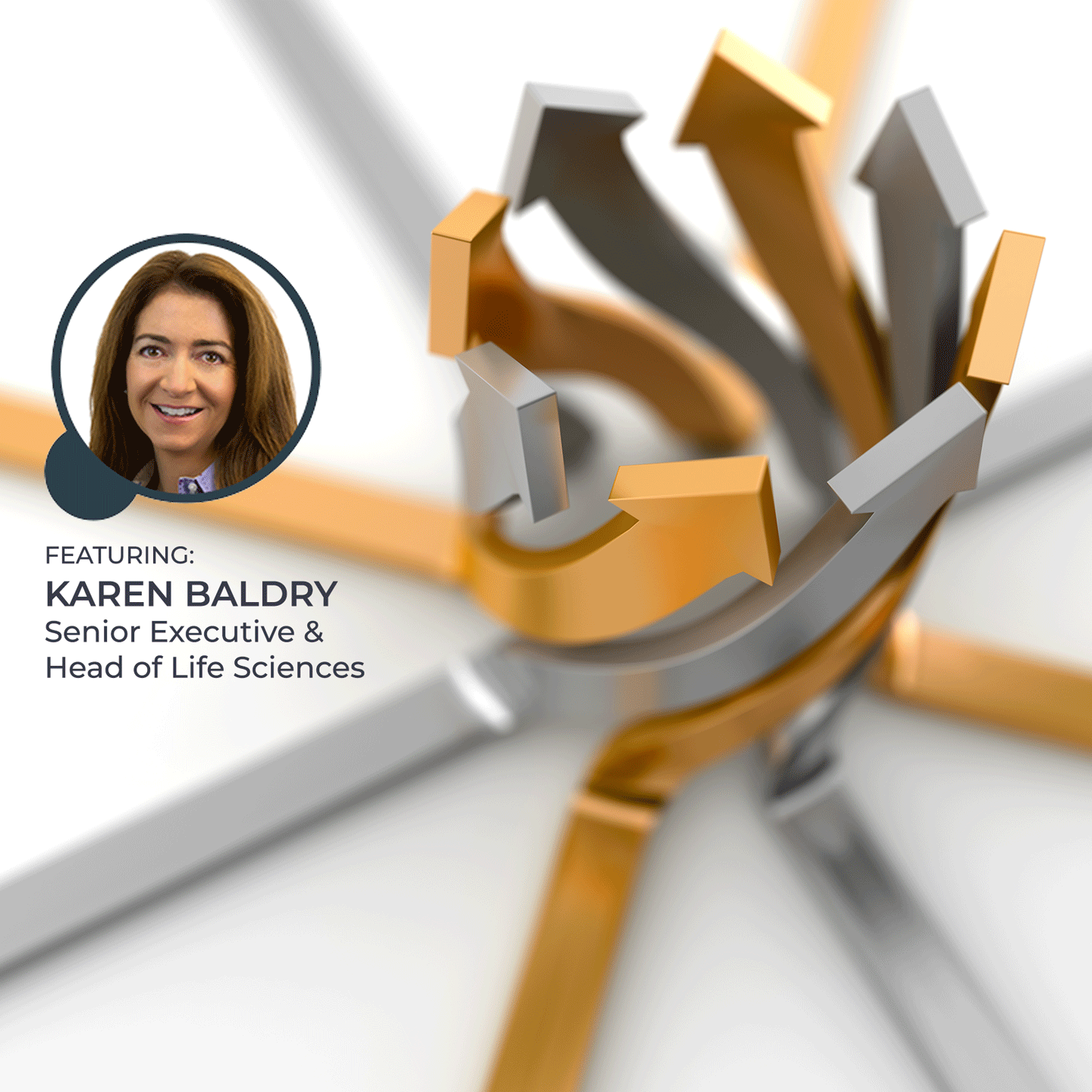Breaking boundaries: The convergence evolution – A life sciences perspective
 Karen Baldry / 29 September 2023
Karen Baldry / 29 September 2023With contributions from: Jen Burke, and Mindy McGrath
Convergence in the health industry represents a transformational imperative for organizations to think and operate differently. Our focus at Vynamic has predominantly been on the impact of traditionally separate entities, such as payers, providers, intermediaries, and technology companies coming together to collaborate and pursue common goals. While it may initially appear that Life Sciences companies are not directly involved in this industry shift, the interconnected nature of the health system means that movement in one sector has a profound ripple effect on others.
In an engaging interview with Karen Baldry, Vynamic’s Head of Life Sciences, we delve into the subject of convergence and its implications on the sector.
Vynamic: We have engaged in numerous discussions centered around convergence in traditional Payers, Provider, and Health Technology sectors. While these players are at the forefront, driving and experiencing the impact of convergence, we also recognize that our Life Sciences clients are actively considering and responding to this shift. From your perspective, how is the Life Sciences sector thinking about convergence and the distinctions compared to other sectors?
Karen: While traditional Health Plans, Provider, and Health Technology organizations are changing their foundational capabilities and business models and truly converging, the core competencies of Life Sciences organizations are evolving, in terms of researching, manufacturing, and distributing therapeutics, but are also in a somewhat reactive position to many of the convergence impacts being driven by other sectors of the health industry.
This is not to say that Life Sciences companies are not being proactive in addressing this shift, but to a certain extent the very nature of where we are seeing convergence take place leads to a more reactionary position. In reacting to this shift, Life Sciences companies are primarily grappling with how changes within core stakeholders, such as payers, providers, and intermediaries could or should change the ways they develop and distribute their products, engage with customers, and provide value beyond their specific product lines. For example, in 2022 the largest 15 pharmacies accounted for more than three-quarters of total U.S. dispensing revenues – and five of the largest were owned by vertically integrated organizations that also own a PBM.1 Companies such as CVS Health, Cigna, and United Health offer health insurance, operate specialty pharmacies, and provide healthcare services. As we outlined in Breaking boundaries: The convergence evolution, these vertically integrated organizations have consolidated distribution channels and increased negotiation power, which means Life Sciences organizations may need to adjust their distribution, pricing, and go-to-market strategies to ensure effective access and reimbursement.
Another example is value-based and primary care-focused providers such as VillageMD, who are acquiring digital solutions and healthcare technologies such as Healthy Interactions that promote patient education and adherence.2 These types of wraparound services may no longer be a differentiator for Life Sciences organizations, which have historically developed their own patient services and solutions. In this case, I think convergence of the best minds and resources will be a positive accelerator to bring the best services and support to patients.
In general, I would say that the forward-thinking Life Sciences companies are looking at the convergence around them and projecting out the short- and long-term impacts, considering the opportunities and challenges it presents, and building it into their strategies.
Vynamic: Speaking of opportunities – how do you see convergence benefitting Life Sciences organizations when it comes to research, development, commercialization, and ultimately, patients?
Karen: Three areas really jump out at me:
1. Better data
When it comes to data, vertical integration promotes a more complete picture of the full patient journey and lifecycle. Instead of cobbling together disparate data sources and using algorithms to match what seems to be the same patient at the doctor’s office, pharmacy, and hospital, we’re going to see health services organizations that have claims data, lab results, and electronic health records together in-house. Life Sciences companies can have more confidence that the data they’re purchasing presents a comprehensive view of what’s truly happening as they analyze disease patterns, treatment responses, and medication safety. And the quality of the data matters a lot – particularly as more advanced and predictive analytic models are adopted. Better data enables evidence-based drug development, justification for the value complex and costly treatments provide, and more informed decision making.
2. Streamlined partnerships
As payers, providers, and technology companies converge, it also streamlines the partner landscape for Life Sciences organizations. Partnerships are an effective way for Life Sciences organizations to access new talent and innovation in a way that offsets risk, builds trust, and promotes value creation for both parties – and data suggests that companies are increasingly pursuing this approach over traditional M&A.3 But partnerships are not without their own challenges. Success necessitates a lengthy due diligence process and establishing a culture of collaboration. Previously, Life Sciences organizations may have had to pursue partnerships with multiple organizations to piece together the comprehensive value story or have been limited to a select set of partners with specific end-to-end capabilities. With convergence, now a single partnership with an integrated health services organization can replace multiple with the individual component companies, allowing Life Science companies to invest more efficiently and realize deeper value from their partnerships.
3. Increased support for complex therapies
The third area where we are hopeful that industry convergence will really benefit patients is in the cell and gene therapy space. With over 1,500 registered clinical trials and a forecasted CAGR (compounded annual growth rate) of 46% between 2022 and 2028, it’s clear that cell and gene therapies are poised to become a growth sector for the Life Sciences market.4 However, as we have seen in recent years, clearing clinical trials and regulatory approvals are necessary but not sufficient to successfully bring these types of therapies to market. These therapies require a high-level of coordination between manufacturers, providers, and payers to actually reach patients. In situations where a single entity is playing the role of both provider and payer, they can serve as a single point of a contact with aligned objectives, reducing complexity for Life Sciences organizations and patients alike. These integrated organizations may also feel more comfortable paying for these high-cost therapies, as they will have the data in-house to back value-based pricing and rebate agreements. Vertically integrated organizations such as CVS Health have even put out perspectives on how payers might manage the cost of these life-changing therapies without curbing their potential.5
Vynamic: I often think of opportunities and challenges as being two sides of the same coin. What challenges do you see convergence presenting for Life Sciences companies – organizationally, culturally, or financially?
Karen: The customer dynamics and power are shifting. We talk a lot about patient centricity and power of the consumer, but individual prescribers and patients may have less autonomy in their treatment choices. Will HCP workflows and treatment protocols be more closely shaped by formulary positioning? Will health services organizations be able to share a “next best action” through their electronic health records based on health economics outcomes data and predictive modeling? From my perspective, the proliferation of vertically integrated health services organizations is only going to increase the importance of the Market Access function. With a smaller number of organizations controlling access to large portions of the market, reaching favorable terms when it comes to distribution and gross-to-net arrangements with these partners will be key to brand success and revenue. Life Sciences organizations will need to ensure customer engagement strategy includes significant input from payer teams. Also, field force operational support will need to go beyond traditional sales and MSL teams to consider the activities and needs of account and contracting teams.
So, it’s a good time for Life Sciences companies to be thinking about their organizational structures, operating models, and capabilities. As their customers shift, how do traditional functions need to evolve their ways of working? Will a new organizational structure better promote the behaviors or collaboration required to be successful in the post-convergence ecosystem? Capabilities should be considered both from a data and talent strategy perspective. With more integrated health services organizations, there may be renewed energy in value-based agreements. These types of agreements require robust data both pre- and post-clinical development, as well as advanced statistical modeling skills. Organizations should assess their talent strategy to make sure they have individuals with the appropriate skills to develop, support, and execute these evolved access strategies.
Vynamic: You mentioned that just because convergence tends to be happening around Life Sciences organizations, it doesn’t mean that they are forced to be in a reactive position. What are a few key things that these companies can be proactively considering or doing when it comes to convergence?
Karen: With so much movement around them, Life Sciences organizations don’t want to be caught flat-footed just because they aren’t the ones blurring the boundaries between sectors. It’s important for them to look at these mergers and acquisitions between payers and health systems and intermediaries and asses the downstream impacts of these ballooning health services organizations. Understanding the flow of data and dollars across these organizations is critical. Is convergence actually simplifying healthcare’s money maze or just changing how things look on paper? Whose incentives are changing and how could that impact their behaviors? Where does that create hurdles for Life Sciences organizations and where does that open new opportunities? How do Life Sciences organizations alter their investment, go-to-market, and people strategies to keep pace? I remain hopeful that convergence can lead to scientific advancements, improved patient care, and expanded market presence. Companies that understand and embrace this evolving landscape will see opportunities for innovation and improved business and patient outcomes in an increasingly integrated and interconnected healthcare ecosystem.
Interested in learning more about Vynamic and our Life Sciences solutions? Contact us to discuss how our team can support your strategic initiatives.
Related Content:
Breaking Boundaries: The convergence evolution
End notes:
- Drug Channels. (2023, March). The Top 15 U.S. Pharmacies of 2022: Market Share and Key Developments.
- PR Newswire. (n.d.). VillageMD Acquires Healthy Interactions, a Patient Education Platform Proven to Increase Medication Adherence for Chronic Conditions.
- EY. (n.d.). Partnerships in Life Sciences Dealmaking: Strategies for Success.
- Cell & Gene. (n.d.). Market Outlook for Cell and Gene Therapies.
- CVS Health Payor Solutions. (2020, January). Gene Therapy: Keeping Costs from Negating Its Unprecedented Potential (White Paper).

About Vynamic
Vynamic, an Inizio Advisory company, is a leading management consulting partner to global health organizations across Life Sciences, Health Services, and Health Technology. Founded and headquartered in Philadelphia, Vynamic has offices in Boston, Durham NC, New York, and London. Our purpose is simple: We believe there is a better way. We are passionate about shaping the future of health, and for more than 20 years we’ve helped clients transform by connecting strategy to action.
Through a structured, yet flexible delivery model, our accomplished leaders work as an extension of client teams, enabling growth, performance, and culture. Vynamic has been recognized by organizations like Great Place to Work and Business Culture Awards for being leaders and innovators in consulting, company culture, and health. Visit Vynamic.com to discover how we can help transform your
organization or your career.
